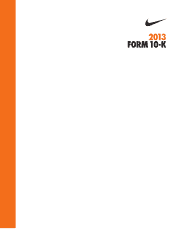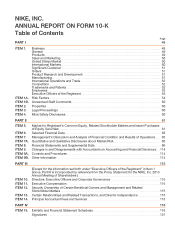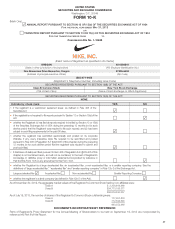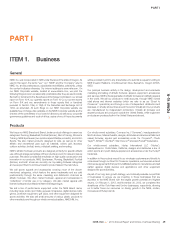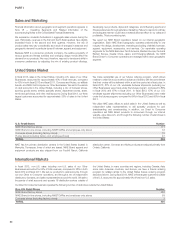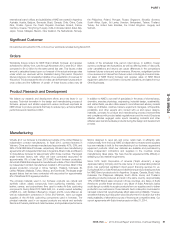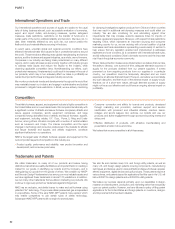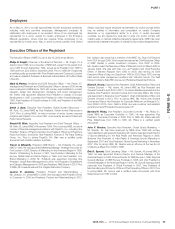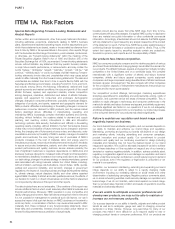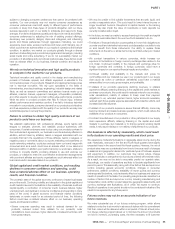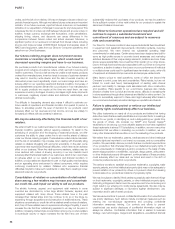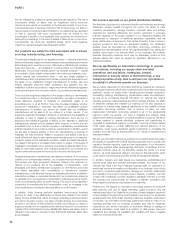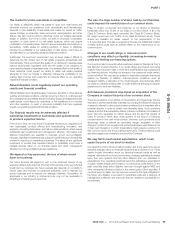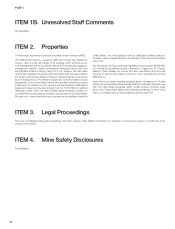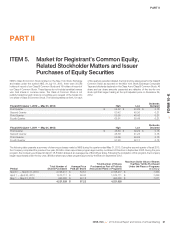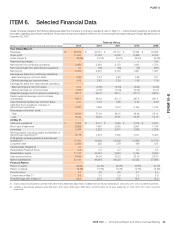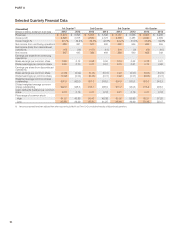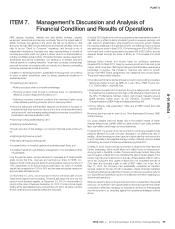Nike 2013 Annual Report Download - page 10
Download and view the complete annual report
Please find page 10 of the 2013 Nike annual report below. You can navigate through the pages in the report by either clicking on the pages listed below, or by using the keyword search tool below to find specific information within the annual report.
PART I
subject to changing consumer preferences that cannot be predicted with
certainty. Our new products may not receive consumer acceptance as
consumer preferences could shift rapidly to different types of performance
products or away from these types of products altogether, and our future
success depends in part on our ability to anticipate and respond to these
changes. If we fail to anticipate accurately and respond to trends and shifts in
consumer preferences by adjusting the mix of existing product offerings,
developing new products, designs, styles and categories, and influencing
sports and fitness preferences through aggressive marketing, we could
experience lower sales, excess inventories and lower profit margins, any of
which could have an adverse effect on our results of operations and financial
condition. In addition, we market our products globally through a diverse
spectrum of advertising and promotional programs and campaigns, including
social media and online advertising. If we do not successfully market our
products or if advertising and promotional costs increase, these factors could
have an adverse effect on our business, financial condition and results of
operation.
We rely on technical innovation and high quality products
to compete in the market for our products.
Technical innovation and quality control in the design and manufacturing
process of footwear, apparel, and athletic equipment is essential to the
commercial success of our products. Research and development plays a key
role in technical innovation. We rely upon specialists in the fields of
biomechanics, exercise physiology, engineering, industrial design and related
fields, as well as research committees and advisory boards made up of
athletes, coaches, trainers, equipment managers, orthopedists, podiatrists,
and other experts to develop and test cutting edge performance products.
While we strive to produce products that help to reduce injury, enhance
athletic performance and maximize comfort, if we fail to introduce technical
innovation in our products, consumer demand for our products could decline,
and if we experience problems with the quality of our products, we may incur
substantial expense to remedy the problems.
Failure to continue to obtain high quality endorsers of our
products could harm our business.
We establish relationships with professional athletes, sports teams and
leagues to evaluate, promote, and establish product authenticity with
consumers. If certain endorsers were to stop using our products contrary to
their endorsement agreements, our business could be adversely affected. In
addition, actions taken by athletes, teams or leagues associated with our
products that harm the reputations of those athletes, teams or leagues, or
negative posts or comments about our sports marketing endorsements on
social networking websites, could also seriously harm our brand image with
consumers and, as a result, could have an adverse effect on our sales and
financial condition. In addition, poor performance by our endorsers, a failure to
continue to correctly identify promising athletes to use and endorse our
products, or a failure to enter into cost effective endorsement arrangements
with prominent athletes and sports organizations could adversely affect our
brand and result in decreased sales of our products.
Global capital and credit market conditions, and resulting
declines in consumer confidence and spending, could
have a material adverse effect on our business, operating
results, and financial condition.
The uncertain state of the global economy continues to impact businesses
around the world. Continuing volatility and disruption in the global capital and
credit markets have led to fluctuations in the availability of business credit and
capital liquidity, a contraction of consumer credit, business failures, higher
unemployment, and declines in consumer confidence and spending in many
parts of the world. If global economic and financial market conditions
deteriorate or remain weak for an extended period of time, the following
factors could have a material adverse effect on our business, operating
results, and financial condition:
•Slower consumer spending may result in reduced demand for our
products, reduced orders from retailers for our products, order
cancellations, lower revenues, higher discounts, increased inventories, and
lower gross margins.
•We may be unable to find suitable investments that are safe, liquid, and
provide a reasonable return. This could result in lower interest income or
longer investment horizons. Disruptions to capital markets or the banking
system may also impair the value of investments or bank deposits we
currently consider safe or liquid.
•In the future, we may be unable to access financing in the credit and capital
markets at reasonable rates in the event we find it desirable to do so.
•The failure of financial institution counterparties to honor their obligations to
us under credit and derivative instruments could jeopardize our ability to rely
on and benefit from those instruments. Our ability to replace those
instruments on the same or similar terms may be limited under poor market
conditions.
•We conduct transactions in various currencies, which increase our
exposure to fluctuations in foreign currency exchange rates relative to the
U.S. Dollar. Continued volatility in the markets and exchange rates for
foreign currencies and contracts in foreign currencies could have a
significant impact on our reported financial results and condition.
•Continued volatility and availability in the markets and prices for
commodities and raw materials we use in our products and in our supply
chain (such as cotton or petroleum derivatives) could have a material
adverse effect on our costs, gross margins, and profitability.
•If retailers of our products experience declining revenues, or retailers
experience difficulty obtaining financing in the capital and credit markets to
purchase our products, this could result in reduced orders for our products,
order cancellations, inability of retailers to timely meet their payment
obligations to us, extended payment terms, higher accounts receivable,
reduced cash flows, greater expense associated with collection efforts, and
increased bad debt expense.
•If retailers of our products experience severe financial difficulty, some may
become insolvent and cease business operations, which could reduce the
availability of our products to consumers.
•If contract manufacturers of our products or other participants in our supply
chain experience difficulty obtaining financing in the capital and credit
markets to purchase raw materials or to finance general working capital
needs, it may result in delays or non-delivery of shipments of our products.
Our business is affected by seasonality, which could result
in fluctuations in our operating results and stock price.
We experience moderate fluctuations in aggregate sales volume during the
year. Historically, revenues in the first and fourth fiscal quarters have slightly
exceeded those in the second and third fiscal quarters. However, the mix of
product sales may vary considerably from time to time as a result of changes
in seasonal and geographic demand for particular types of footwear, apparel
and equipment. In addition, our customers may cancel orders, change
delivery schedules or change the mix of products ordered with minimal notice.
As a result, we may not be able to accurately predict our quarterly sales.
Accordingly, our results of operations are likely to fluctuate significantly from
period to period. This seasonality, along with other factors that are beyond our
control, including general economic conditions, changes in consumer
preferences, weather conditions, availability of import quotas and currency
exchange rate fluctuations, could adversely affect our business and cause our
results of operations to fluctuate. Our operating margins are also sensitive to a
number of factors that are beyond our control, including manufacturing and
transportation costs, shifts in product sales mix, geographic sales trends, and
currency exchange rate fluctuations, all of which we expect to continue.
Results of operations in any period should not be considered indicative of the
results to be expected for any future period.
Futures orders may not be an accurate indication of our
future revenues.
We make substantial use of our futures ordering program, which allows
retailers to order five to six months in advance of delivery with the commitment
that their orders will be delivered within a set period of time at a fixed price.
Our futures ordering program allows us to minimize the amount of products
we hold in inventory, purchasing costs, the time necessary to fill customer
NIKE, INC. 2013 Annual Report and Notice of Annual Meeting 55
FORM 10-K

